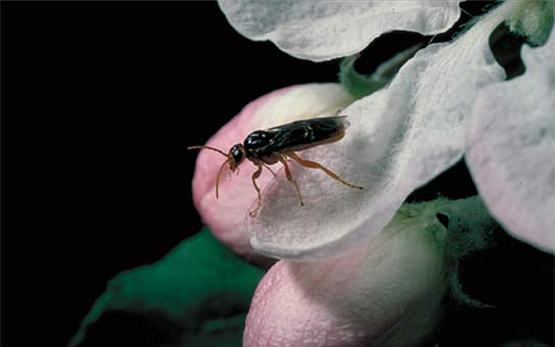We develop forecasting models in order to optimize timing of monitoring, management, and control measures of insect pests in fruit orchards. Applying time-varying distributed delay approaches, phenology models are developed driven by several weather parameters on hourly basis. The implementation of insect body temperatures in the models is based on intensive studies on habitat selection and/or thermoregulation behaviour of the different developmental stages and biophysical modelling using weather and structural orchard parameters. Relationships between temperature and stage specific development rates for the relevant stages of the life cycles are established in thorough laboratory experiments under controlled conditions. For validation, implemented model predictions are compared with independent field observations from several years.
Phenology models are established for Dysaphis plantaginea, Hoplocampa testudinea, Cydia pomonella, Grapholita lobarzewskii, Cacopsylla pyri, Rhagoletis cerasi, Anthonomus pomorum and Adoxophyes orana, Panonychus ulmi, Grapholita funebrana. Coverage of major orchard pests is successively extended.

SOPRA : Research Instrument and Decision Support System
Our validated phenology models are combined in the forecasting tool SOPRA. On base of local weather data, the system simulates detailed age structure of pome and stone fruit pest populations and on that basis announces crucial events for management activities. Our system allows to facilitate routine simulations for application in agricultural practice as well as simulations applied for research. For instance we use SOPRA to model the effect of climate change on phenology of pest insects and for deriving implications to adapt management strategies in the future. Through the web-interface of SOPRA we make simulation results available to growers and consultants (www.sopra.info). Together with extended information on pest species and management options thereby SOPRA is applied as decision support system for orchard pest.
Evaluation and Development of Monitoring Tools
For relevant pest insects in fruit tree and vegetable growing, monitoring tools on base of physical techniques or pheromone trapping are developed and evaluated with respect to the factors influencing trap catches (e.g., trapping position, insect dispersal behaviour), correlation between trap catches and damage or actual pest abundance, and their general efficacy.
Project Information
Project Title:
Forecasting, Monitoring and Sustainable Control of Pests in Orchard-Fruit and Field-Vegetable Production Systems





